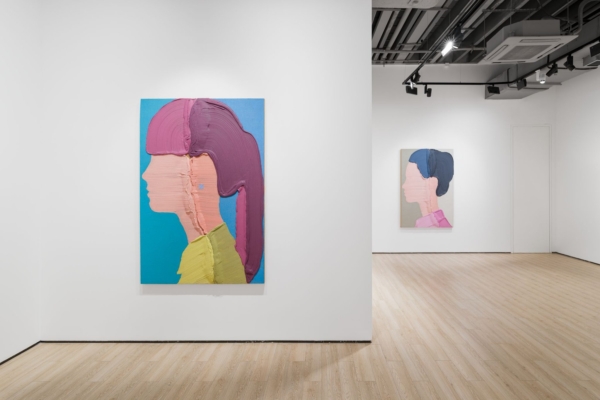José Lerma's recent hyper-painterly portraits are paradoxically austere. The copious amount of paint loaded onto each canvas counters the scant number of brushstrokes: only three to ten per piece. Though impasto typically conveys dynamism and spontaneity, here it rigidly describes static heads from the front or side. Stark and solemn, the faces in profile evoke Piero della Francesca's classicising double portrait of the Duke and Duchess of Urbino. Only in place of the early Renaissance master's diaphanous oil glazes is the opposite extreme: clotted slabs of acrylic. With so few marks and fast-drying paint thickened with gels and other materials, Lerma's pictures require careful planning. This methodical process and the profound quietude of the resulting images neutralises the improvisational bravura associated with gestural brushwork. Beyond the unlikely marriage of seductive expressionism and severe neoclassicism, the series contains many more contradictions that challenge expectations of both painting and portraits.
Traditionally, painted portraits served to identify and memorialise kings, queens, and other elite members of society. Profile views, prevalent on the ancient Roman coins that inspired Piero, were thought to provide the most accurate likeness. Renaissance portrait painters like Piero not only sought to capture the outward appearance of their subjects, but also their status and character. It was not until the era of photography that portraits become democratised; that is, it was no longer a costly luxury to have one's portrait made. Today photographic 'selfies' are among the most common images people encounter on a daily basis.
Lisa, 2022, acrylic on burlap, 72 x 48 in
Lerma's current portrait paintings frustrate the desire to recognise a particular person—through distinctive facial features and/or character traits—in a depiction referred to as a 'portrait.' Each work is titled after the first name of the sitter, a mode of address that suggests some level of familiarity and even intimacy between artist and subject. Indeed, many of the titular individuals are Lerma's neighbours and friends in San Juan and Chicago, where he splits his time. Though based on specific people, the portraits are simplified to the point that likeness becomes indeterminate. Varying hairstyles distinguish one person from the next, but their blank visages allow the viewer to project imagined identities onto each. As resemblance recedes, paint itself comes to the forefront. Of course, the very abundance of paint, projecting outward from the canvas, further establishes its position of prominence. In place of metaphorical, psychological depth in the faces portrayed, we find literal depth in the thickness of paint. For Lerma, the portrait is the vehicle for the paint as much as the other way around.
Rebekah, 2022, acrylic on burlap, 72 x 48 in
In addition to portraits, the paintings also contain landscapes. Viewed independently of the image, the peaks and valleys of paint appear topographical. The accretion of material where brushstrokes meet is like the mountainous ridges formed by tectonic plates. Lerma has fittingly described himself as a "landscape painter" since his work always emerges from his surroundings—in this case, the people around him in Puerto Rico, where he paints outside in an abandoned tennis court.
In the larger works, ranging from six to eight feet tall, Lerma uses a commercial broom to create gigantic brushstrokes. The effect is of a small study that has been enlarged. Shifting scale is another way to dismantle hierarchies and bestow importance on the marginalised. Blown up, seemingly casual sketches of local acquaintances assume the magnitude of aristocratic portraits. The ambiguous scale also destabilises the viewer's sense of their own size, allowing them to imagine they are indeed looking at a tiny sketch but through the eyes of a child.
Thus further paradoxes emerge: specific and general, figurative and abstract, three-dimensional and flat, organic and synthetic, living and unmoving, portrait and landscape, small and big. Though seemingly placid, Lerma's portraits shuttle between these poles and subtly disrupt our assumptions about what we see so that we may return to an open, curious, childlike state of mind.
— Antonia Pocock, independent scholar
Antonia Pocock, Ph.D., is a scholar of modern and contemporary art and adjunct instructor of art history at Marymount Manhattan College in New York. Her most recent publications include an article on Fluxus artist and musician Ben Patterson in Nka: Journal of Contemporary African Art (May 2022) and an essay on the reclusive multimedia artist Bettina Grossman in the catalogue Bettina (Paris: Atelier EXB, 2022). She is currently working on her first book, a study of New York Pop art and Chicago Imagism.




Comentarios
Publicar un comentario